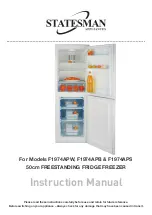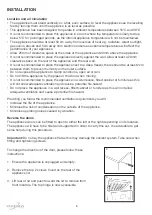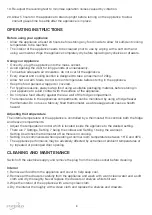
8
19. Re-adjust the levelling feet to minimise operation noises caused by vibration.
20. Allow 5 hours for the appliance to stand upright before turning on the appliance to allow
coolant gases time to settle after the appliance is in place.
OPERATING INSTRUCTIONS
Before using your appliance
• Allow the appliance at least 24 hours before storing any food inside to allow for sufficient cooling
temperature to be reached.
• The interior of the appliance needs to be cleaned prior to use by wiping with a soft cloth and
using warm water. Wipe the appliance completely dry before replacing any shelves or drawers.
Using your Appliance
• Once dry, plug the appliance into the mains socket.
• Avoid opening the door for long periods or unnecessarily.
• To maintain adequate air circulation, do not over fill the appliance.
• Every drawer and cooling section is designed to take a maximum of 20kg.
• Allow hot or warm foods to cool to room temperature before storing in the appliance.
• Keep the food packed, wrapped or covered.
• For hygiene reasons, always wrap food using a suitable packaging material, before storing in
your appliance to avoid contact with the surface of the appliance.
• Do not place food directly against the rear wall of the fridge compartment.
• The temperature in the appliances compartments can be monitored by using a fridge freezer
thermometer. Do not use a Mercury filled thermometer, as a breakage would cause a health
hazard.
Adjusting the temperature
The internal temperature of the appliance is controlled by a thermostat; this controls both the fridge
and freezer compartments.
• Adjust the temperature control which is located inside the appliance to the desired setting.
• There are 7 Settings, Setting 7 being the coldest and Setting 1 being the warmest.
Setting 0 switches the thermostat off so there is no cooling.
• Setting 4 is recommended when operating at normal room temperature between 16°C and 38°C.
• The appliance performance may be adversely affected by extremes of ambient temperatures or
by repeated or prolonged door opening.
CLEANING AND MAINTENANCE
Switch off the electrical supply and remove the plug from the mains socket before cleaning.
Interior
1. Remove all food from the appliance and cover to help keep cool.
2. Remove all the drawers carefully from the appliance and wash with warm clean water and a soft
cloth and dry thoroughly. Never replace the drawers or shelves whilst still wet.
3. Wipe the interior of the appliance with a damp clean cloth.
4. Dry the interior thoroughly with a clean cloth and replace the shelves and drawers.






























